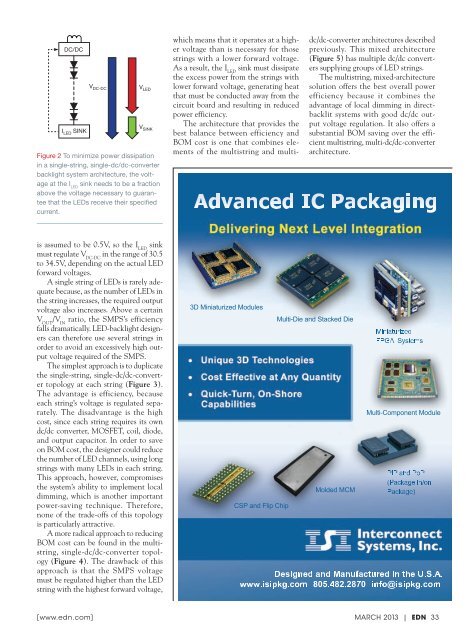201303.pdf 36567KB Mar 22 2013 09:11:22 PM
201303.pdf 36567KB Mar 22 2013 09:11:22 PM
201303.pdf 36567KB Mar 22 2013 09:11:22 PM
You also want an ePaper? Increase the reach of your titles
YUMPU automatically turns print PDFs into web optimized ePapers that Google loves.
DC/DC<br />
I LED SINK<br />
V DC-DC<br />
V LED<br />
V SINK<br />
Figure 2 To minimize power dissipation<br />
in a single-string, single-dc/dc-converter<br />
backlight system architecture, the voltage<br />
at the I LED<br />
sink needs to be a fraction<br />
above the voltage necessary to guarantee<br />
that the LEDs receive their specified<br />
current.<br />
which means that it operates at a higher<br />
voltage than is necessary for those<br />
strings with a lower forward voltage.<br />
As a result, the I LED<br />
sink must dissipate<br />
the excess power from the strings with<br />
lower forward voltage, generating heat<br />
that must be conducted away from the<br />
circuit board and resulting in reduced<br />
power efficiency.<br />
The architecture that provides the<br />
best balance between efficiency and<br />
BOM cost is one that combines elements<br />
of the multistring and multi-<br />
dc/dc-converter architectures described<br />
previously. This mixed architecture<br />
(Figure 5) has multiple dc/dc converters<br />
supplying groups of LED strings.<br />
The multistring, mixed-architecture<br />
solution offers the best overall power<br />
efficiency because it combines the<br />
advantage of local dimming in directbacklit<br />
systems with good dc/dc output<br />
voltage regulation. It also offers a<br />
substantial BOM saving over the efficient<br />
multistring, multi-dc/dc-converter<br />
architecture.<br />
Advanced IC Packaging<br />
is assumed to be 0.5V, so the I LED<br />
sink<br />
must regulate V DC-DC<br />
in the range of 30.5<br />
to 34.5V, depending on the actual LED<br />
forward voltages.<br />
A single string of LEDs is rarely adequate<br />
because, EDN1303DF2 as the Fig number 2.eps of DIANE LEDs in<br />
the string increases, the required output<br />
voltage also increases. Above a certain<br />
V OUT<br />
/V IN<br />
ratio, the SMPS’s efficiency<br />
falls dramatically. LED-backlight designers<br />
can therefore use several strings in<br />
order to avoid an excessively high output<br />
voltage required of the SMPS.<br />
The simplest approach is to duplicate<br />
the single-string, single-dc/dc-converter<br />
topology at each string (Figure 3).<br />
The advantage is efficiency, because<br />
each string’s voltage is regulated separately.<br />
The disadvantage is the high<br />
cost, since each string requires its own<br />
dc/dc converter, MOSFET, coil, diode,<br />
and output capacitor. In order to save<br />
on BOM cost, the designer could reduce<br />
the number of LED channels, using long<br />
strings with many LEDs in each string.<br />
This approach, however, compromises<br />
the system’s ability to implement local<br />
dimming, which is another important<br />
power-saving technique. Therefore,<br />
none of the trade-offs of this topology<br />
is particularly attractive.<br />
A more radical approach to reducing<br />
BOM cost can be found in the multistring,<br />
single-dc/dc-converter topology<br />
(Figure 4). The drawback of this<br />
approach is that the SMPS voltage<br />
must be regulated higher than the LED<br />
string with the highest forward voltage,<br />
3D Miniaturized Modules<br />
CSP and Flip Chip<br />
Multi-Die and Stacked Die<br />
Molded MCM<br />
Miniaturized<br />
FPGA Systems<br />
Multi-Component Module<br />
PiP and PoP<br />
(Package in/on<br />
Package)<br />
Designed and Manufactured in the U.S.A.<br />
www.isipkg.com 805.482.2870 info@isipkg.com<br />
[ www.edn.com ] <strong>Mar</strong>ch <strong>2013</strong> | EDN 33






![[270].pdf 37407KB Sep 02 2010 09:55:57 AM - ElectronicsAndBooks](https://img.yumpu.com/50350834/1/185x260/270pdf-37407kb-sep-02-2010-095557-am-electronicsandbooks.jpg?quality=85)
![draaien, A Viruly 1935 OCR c20130324 [320]. - ElectronicsAndBooks](https://img.yumpu.com/49957773/1/190x252/draaien-a-viruly-1935-ocr-c20130324-320-electronicsandbooks.jpg?quality=85)



![20051110 c20051031 [105].pdf 35001KB Feb 18 2009 08:46:32 PM](https://img.yumpu.com/48687202/1/190x253/20051110-c20051031-105pdf-35001kb-feb-18-2009-084632-pm.jpg?quality=85)





